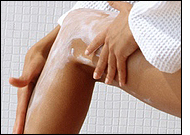 |
| |
 |
 |
|
Lymphedema is a blockage of the lymph vessels resulting in an accumulation
of lymph fluid, which leads to chronic swelling of the arms, legs or other
body parts.
The lymphatic system is responsible for removing lymph fluid, consisting
of fat, protein, water and cell waste, from the tissue spaces. When lymph
vessels become blocked or damaged, excess lymph fluids begin to accumulate.
Lymphedema can affect infants, children, women and men of all ages. If
left, untreated, lymphedema will progress and increase in severity.
The symptoms of lymphedema vary with each individual. However, some common
symptoms include:
- Swelling
of the Arm(s), Leg(s) or Other Parts of the Body
- A Feeling
of Heaviness or Discomfort in the Affected Body Part, Which May Result
in a Loss of Mobility
- Recurrent
Infections in the Affected Area
- Hardening
or Thickening of the Skin in the Affected Area
- Lymph
Fluid Leaking Through the Skin
Patients experiencing lymphedema have either primary or secondary lymphedema.
Primary Lymphedema
Primary lymphedema is a result of congenital malformation of the lymphatic
system. Primary lymphedema may be present at birth, occur later in life,
depending on the type and degree of malformation present. This is usually
hereditary and affects females more often than males.
Secondary Lymphedema
Secondary lymphedema is a result of damage to the lymphatic system caused
by infection, radiation, surgery or other trauma. Common causes are treatment
for breast cancer and chronic circulatory problems of the lower extremities.
The recommended treatment for lymphedema is Complete Decongestive Therapy
(CDT) comprised of four components. It is performed in two phases. Treatment
at St. Rita’s Lymphedema Program is provided on an outpatient basis by an
experienced therapy staff certified in CDT.
Manual Lymph Drainage (MLD)
This is a gentle manual treatment performed directly on the skin to improve
the activity of the lymphatic system. Manual treatment stimulates the lymph
vessels in the trunk that carry lymph fluid to the other lymph nodes. Next,
the lymph fluid in the congested limb is gently directed toward the healthy
nodes. From there, the lymph is transported back into the blood system.
Compression Bandaging
After
each MLD session, the affected limb or body part is wrapped with bandages
to prevent re-accumulation of lymph fluid in the affected area. These bandages
are short-stretch bandages, which apply a graded pressure to the limb.
Patients are taught this wrapping technique and instructed to wear the bandages
until the next treatment session during phase one.
Exercise
Gentle exercise is incorporated into treatment to improve the lymph vessel
activity and improve the lymph circulation. These exercises are performed
while the bandages are in place. This provides a semi-rigid barrier for
the muscles to pump against, which in turn improves lymph circulation.
Skin & Nail Care Education
 Diligent skin and nail care are important in the management of lymphedema.
As the affected limb swells, the body’s ability to fight infection in that
area is decreased, resulting in frequent infections. These infections occur
as cellulitis, lymphangitis or fungal infections of the nails.
Diligent skin and nail care are important in the management of lymphedema.
As the affected limb swells, the body’s ability to fight infection in that
area is decreased, resulting in frequent infections. These infections occur
as cellulitis, lymphangitis or fungal infections of the nails.
Patients are taught skin care precautions, including the use of low pH,
lanolin based lotion. This keeps the affected region well hydrated and decreases
the chance of skin cracks through which infection can enter.
Phase I
Phase one involves daily therapy (five days a week) with a goal of maximum
decongestion of the involved area. Patients in this phase wear short stretch
compression bandages at all times except during manual lymph drainage. Once
the amount of lymphedema decreases and begins to stabilize, patients are
fit for a compression garment and progress into phase two.
Phase II
In phase two, treatment focuses on progressing patients to independent home
management of their lymphedema. The frequency of visits is gradually decreased
until the patient is independent. Patients in this phase wear their compression
garments during the day and bandages at night. This self-maintenance will
last a lifetime.
There is no cure for lymphedema; therefore it is essential to treat and
manage the condition effectively. Complete decongestive therapy can help
to decrease swelling of the affected area, decrease the incidence of infections
and improve function of the affected arm and leg.
|
 |
For More Information
(419) 226-4502
|
| Did You Know: |
| Lymphedema
is the swelling of skin and tissue because of obstructed lymphatic
vessels or lymph nodes causing large amounts of lymph fluid to build
up in the affected region. |
| Lymphatic System: |
| The
lymphatic system is part of the immune system that helps the body
fight to infections. The lymphatic system includes a network of vessels
that drain tissue fluid (lymph) into lymph nodes, larger fluid-containing
lymph ducts and specialized organs involved in the immune system. |
| Did You Know: |
| Complete
decongestive therapy includes proper skin hygiene, manual lymphatic
drainage, bandaging and compression and exercise. |
| Lymphedema: |
"I
felt sorrow about the changes in life"
Lymphedema can cause social inhibition, depression, embarrassment,
cosmetic problems and many life style changes for those afflicted.
Know that help is available to improve the quality of life for people
with lymphedema. |
|

